Comparative Study and Simulation of Capacitive Sensors in Microfluidic Channels for Sensitive Red Blood Cell Detection
Abstract
1. Introduction
2. Detection Principle
3. Conformal Mapping
4. Capacitive Sensor Design
- For 2D/3D PPC structures, HPPC = SPPC is fixed by the channel height (HμF) and width (WμF) to 25 μm, while the IDC length is set to the channel width (LIDC = WμF). Thus, using Equations (3), (4) and (8) is obtained:Using Equations (5)–(7), SIDC and WIDC can be written in terms of given LPPC.
- Assuming capacitive sensors occupy the same detection volume (Dvol) in microfluidic channel, we can use;
- Length of the PPC structure is set to the maximum size of the bioparticle. Thus, LPPC is set to 8 μm since healthy RBCs average diameter is typically between 7.5 μm and 8.7 μm.
- Using Equations (5)–(8) and (10), dimensions of the IDC can be determined, resulting in similar capacitance values, as shown in Figure 3a,b for a 25 μm microfluidic channel.
5. Red Blood Cell (RBC) Properties for Simulation
6. Simulation Results
- A.
- Different RBC Size
- B.
- Different Z-Locations
- C.
- Different Y-Locations
- D.
- Different X-Locations
- E.
- E-Field Distributions
7. Conclusions
Author Contributions
Funding
Institutional Review Board Statement
Informed Consent Statement
Data Availability Statement
Conflicts of Interest
References
- Alley, G. Interdigital Capacitors and Their Application to Lumped-Element Microwave Integrated Circuits. IEEE Trans. Microw. Theory Tech. 1970, 18, 1028–1033. [Google Scholar] [CrossRef]
- Esfandiari, R.; Siracusa, M.; Maki, D. Design of Interdigitated Capacitors and Their Application to Gallium Arsenide Monolithic Filters. IEEE Trans. Microw. Theory Tech. 1983, 31, 57–64. [Google Scholar] [CrossRef]
- Heerens, W.-C. Application of capacitance techniques in sensor design. J. Phys. E Sci. Instrum. 1986, 19, 897–906. [Google Scholar] [CrossRef]
- Puers, R. Capacitive sensors: When and how to use them. Sensors Actuators A Phys. 1993, 37–38, 93–105. [Google Scholar] [CrossRef]
- Baxter, L.K. Capacitive Sensors: Design and Applications; Wiley-IEEE Press: Piscataway, NJ, USA, 1997; Available online: http://www.wiley.com/WileyCDA/WileyTitle/productCd-078035351X,miniSiteCd-IEEE2.html (accessed on 2 October 2018).
- Berggren, C.; Bjarnason, B.; Johansson, G. Capacitive Biosensors. Electroanalysis 2001, 13, 173–180. [Google Scholar] [CrossRef]
- Berney, H. Capacitance Affinity Biosensors. In Ultrathin Electrochemical Chemo- and Biosensors: Technology and Performance; Mirsky, V.M., Ed.; Springer: Berlin/Heidelberg, Germany, 2004; pp. 43–65. [Google Scholar] [CrossRef]
- Bataillard, P.; Gardies, F.; Jaffrezic-Renault, N.; Martelet, C.; Colin, B.; Mandrand, B. Direct detection of immunospecies by capacitance measurements. Anal. Chem. 1988, 60, 2374–2379. [Google Scholar] [CrossRef]
- Tsouti, V.; Boutopoulos, C.; Zergioti, I.; Chatzandroulis, S. Capacitive microsystems for biological sensing. Biosens. Bioelectron. 2011, 27, 1–11. [Google Scholar] [CrossRef]
- Carlsson, E.; Gevorgian, S. Conformal mapping of the field and charge distributions in multilayered substrate CPWs. IEEE Trans. Microw. Theory Tech. 1999, 47, 1544–1552. [Google Scholar] [CrossRef]
- McGahay, V. Conformal Mapping Solution for Interdigital Comb Capacitors between Ground Planes. IEEE Electron Device Lett. 2015, 36, 838–840. [Google Scholar] [CrossRef]
- Schinzinger, R.; Laura, P.A.A. Conformal Mapping: Methods and Applications, Illustrated Edition; Dover Publications: Mineola, NY, USA, 2012. [Google Scholar]
- Tesla, N. Electrical Condenser, US464667A. 8 December 1891. Available online: https://patents.google.com/patent/US464667/en?oq=464667 (accessed on 21 March 2021).
- Maxwell, J.C. A Treatise on Electricity and Magnetism; Macmillan and Co., Ltd.: London, UK, 1873; Volume 1. [Google Scholar]
- Sherman, S.J.; Tsang, W.K.; Core, T.A.; Quinn, D.E. A low cost monolithic accelerometer. In 1992 Symposium on VLSI Circuits Digest of Technical Papers; IEEE: Piscataway, NJ, USA, 1992; pp. 34–35. [Google Scholar] [CrossRef]
- Beeby, S.; Ensell, G.; Kraft, M.; White, N. MEMS Mechanical Sensors; Artech House: Boston, MA, USA, 2004. [Google Scholar]
- Mamishev, A.; Sundara-Rajan, K.; Yang, F.; Du, Y.; Zahn, M. Interdigital sensors and transducers. Proc. IEEE 2004, 92, 808–845. [Google Scholar] [CrossRef]
- Carminati, M.; Thewes, R.; Rosenstein, J.; Yoo, H.-J. Advances and Open Challenges for Integrated Circuits Detecting Bio-Molecules. In Proceedings of the 2018 25th IEEE International Conference on Electronics, Circuits and Systems (ICECS), Bordeaux, France, 9–12 December 2018; pp. 857–860. [Google Scholar] [CrossRef]
- Carminati, M. Advances in High-Resolution Microscale Impedance Sensors. J. Sensors 2017, 2017, e7638389. [Google Scholar] [CrossRef]
- Ghafar-Zadeh, E.; Sawan, M. CMOS Capacitive Sensors for Lab-on-Chip Applications; Springer: Dordrecht, The Netherlands, 2010. [Google Scholar] [CrossRef]
- Adekanmbi, E.O.; Srivastava, S.K. Dielectrophoretic applications for disease diagnostics using lab-on-a-chip platforms. Lab Chip 2016, 16, 2148–2167. [Google Scholar] [CrossRef] [PubMed]
- Ciccarella, P.; Carminati, M.; Sampietro, M.; Ferrari, G. Multichannel 65 zF rms Resolution CMOS Monolithic Capacitive Sensor for Counting Single Micrometer-Sized Airborne Particles on Chip. IEEE J. Solid-State Circuits 2016, 51, 2545–2553. [Google Scholar] [CrossRef]
- Adekanmbi, E.O.; Giduthuri, A.T.; Srivastava, S.K. Dielectric Characterization and Separation Optimization of Infiltrating Ductal Adenocarcinoma via Insulator-Dielectrophoresis. Micromachines 2020, 11, 340. [Google Scholar] [CrossRef]
- Driscoll, T.A.; Trefethen, L.N. Schwarz-Christoffel Mapping; Cambridge University Press: Cambridge, UK, 2002. [Google Scholar] [CrossRef]
- Vendik, O.G.; Zubko, S.P.; Nikol’Skii, M.A. Modeling and calculation of the capacitance of a planar capacitor containing a ferroelectric thin film. Tech. Phys. 1999, 44, 349–355. [Google Scholar] [CrossRef]
- Ye, Y.; Zhang, C.; He, C.; Wang, X.; Huang, J.; Deng, J. A Review on Applications of Capacitive Displacement Sensing for Capacitive Proximity Sensor. IEEE Access 2020, 8, 45325–45342. [Google Scholar] [CrossRef]
- Adekanmbi, E.O.; Dustin, J.; Srivastava, S.K. Electro-osmotic surface effects generation in an electrokinetic-based transport device: A comparison of RF and MW plasma generating sources. Electrophoresis 2019, 40, 1573–1579. [Google Scholar] [CrossRef]
- Gevorgian, S.; Martinsson, T.; Linner, P.; Kollberg, E. CAD models for multilayered substrate interdigital capacitors. IEEE Trans. Microw. Theory Tech. 1996, 44, 896–904. [Google Scholar] [CrossRef]
- Igreja, R.; Dias, C. Analytical evaluation of the interdigital electrodes capacitance for a multi-layered structure. Sens. Actuators A Phys. 2004, 112, 291–301. [Google Scholar] [CrossRef]
- Bao, X.; Ocket, I.; Bao, J.; Liu, Z.; Puers, B.; Schreurs, D.M.M.-P.; Nauwelaers, B. Modeling of Coplanar Interdigital Capacitor for Microwave Microfluidic Application. IEEE Trans. Microw. Theory Tech. 2019, 67, 2674–2683. [Google Scholar] [CrossRef]
- Adekanmbi, E.O.; Srivastava, S.K. Dielectric characterization of bioparticles via electrokinetics: The past, present, and the future. Appl. Phys. Rev. 2019, 6, 041313. [Google Scholar] [CrossRef]
- Srivastava, S.K.; Artemiou, A.; Minerick, A.R. Direct current insulator-based dielectrophoretic characterization of erythrocytes: ABO-Rh human blood typing. Electrophoresis 2011, 32, 2530–2540. [Google Scholar] [CrossRef] [PubMed]
- Foster, K.R.; Schwan, H.P. Dielectric properties of tissues and biological materials: A critical review. Crit. Rev. Biomed. Eng. 1989, 17, 25–104. [Google Scholar]
- Engelhardt, H.; Gaub, H.; Sackmann, E. Viscoelastic properties of erythrocyte membranes in high-frequency electric fields. Nature 1984, 307, 378–380. [Google Scholar] [CrossRef]
- Adamo, A.; Sharei, A.; Adamo, L.; Lee, B.; Mao, S.; Jensen, K.F. Microfluidics-Based Assessment of Cell Deformability. Anal. Chem. 2012, 84, 6438–6443. [Google Scholar] [CrossRef]
- Xu, T.; Lizarralde, M.; El Nemer, W.; Le Pioufle, B.; Français, O. Monitoring Biological Cell Flow within a Mimicking Capillary Device with Impedance Measurement. Multidiscip. Digit. Publ. Inst. Proc. 2017, 1, 517. [Google Scholar] [CrossRef]
- Qiang, Y.; Liu, J.; Dao, M.; Suresh, S.; Du, E. Mechanical fatigue of human red blood cells. Proc. Natl. Acad. Sci. USA 2019, 116, 19828–19834. [Google Scholar] [CrossRef]
- Français, O.; le Pioufle, B. Handbook of Electroporation; Miklavcic, D.D., Ed.; Springer: Cham, Switzerland, 2016; pp. 1–18. [Google Scholar]
- Enz, C.C.; Temes, G.C. Circuit techniques for reducing the effects of op-amp imperfections: Autozeroing, correlated double sampling, and chopper stabilization. Proc. IEEE 1996, 84, 1584–1614. [Google Scholar] [CrossRef]
- Bagheri, A.; Salam, M.T.; Velazquez, J.L.P.; Genov, R. Low-Frequency Noise and Offset Rejection in DC-Coupled Neural Amplifiers: A Review and Digitally-Assisted Design Tutorial. IEEE Trans. Biomed. Circuits Syst. 2016, 11, 161–176. [Google Scholar] [CrossRef]
- Ciccarella, P.; Carminati, M.; Sampietro, M.; Ferrari, G. 28.7 CMOS monolithic airborne-particulate-matter detector based on 32 capacitive sensors with a resolution of 65zF rms. In Proceedings of the 2016 IEEE International Solid-State Circuits Conference (ISSCC), San Francisco, CA, USA, 31 January–4 February 2016; pp. 486–488. [Google Scholar] [CrossRef]
- Diaz, M.; Herrero, M.; Garcia, L.A.; Quiros, C. Flow cytometry: A high-throughput technique for microbial bioprocess characterization. In Comprehensive Biotechnology, 2nd ed.; Moo-Young, M., Ed.; Academic Press: Cambridge, MA, USA, 2011; pp. 967–981. [Google Scholar]
- Pethig, R. Review Article—Dielectrophoresis: Status of the theory, technology, and applications. Biomicrofluidics 2010, 4, 022811. [Google Scholar] [CrossRef]

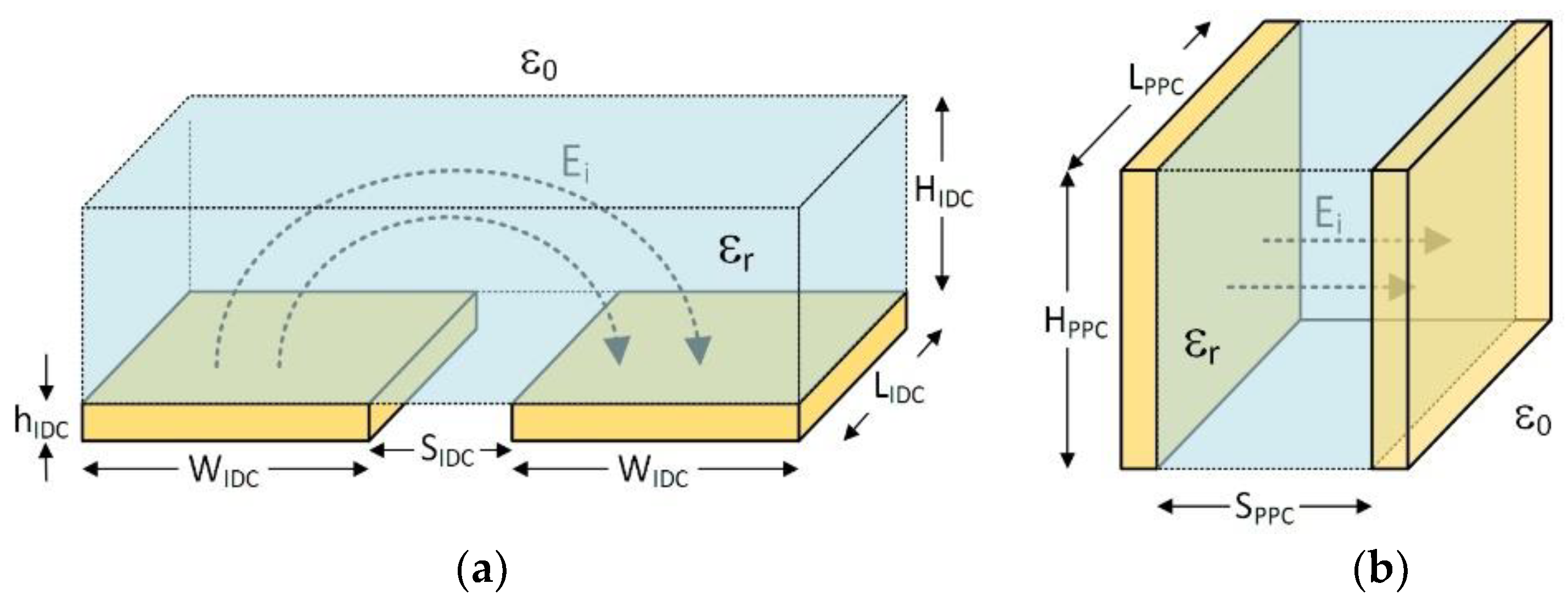
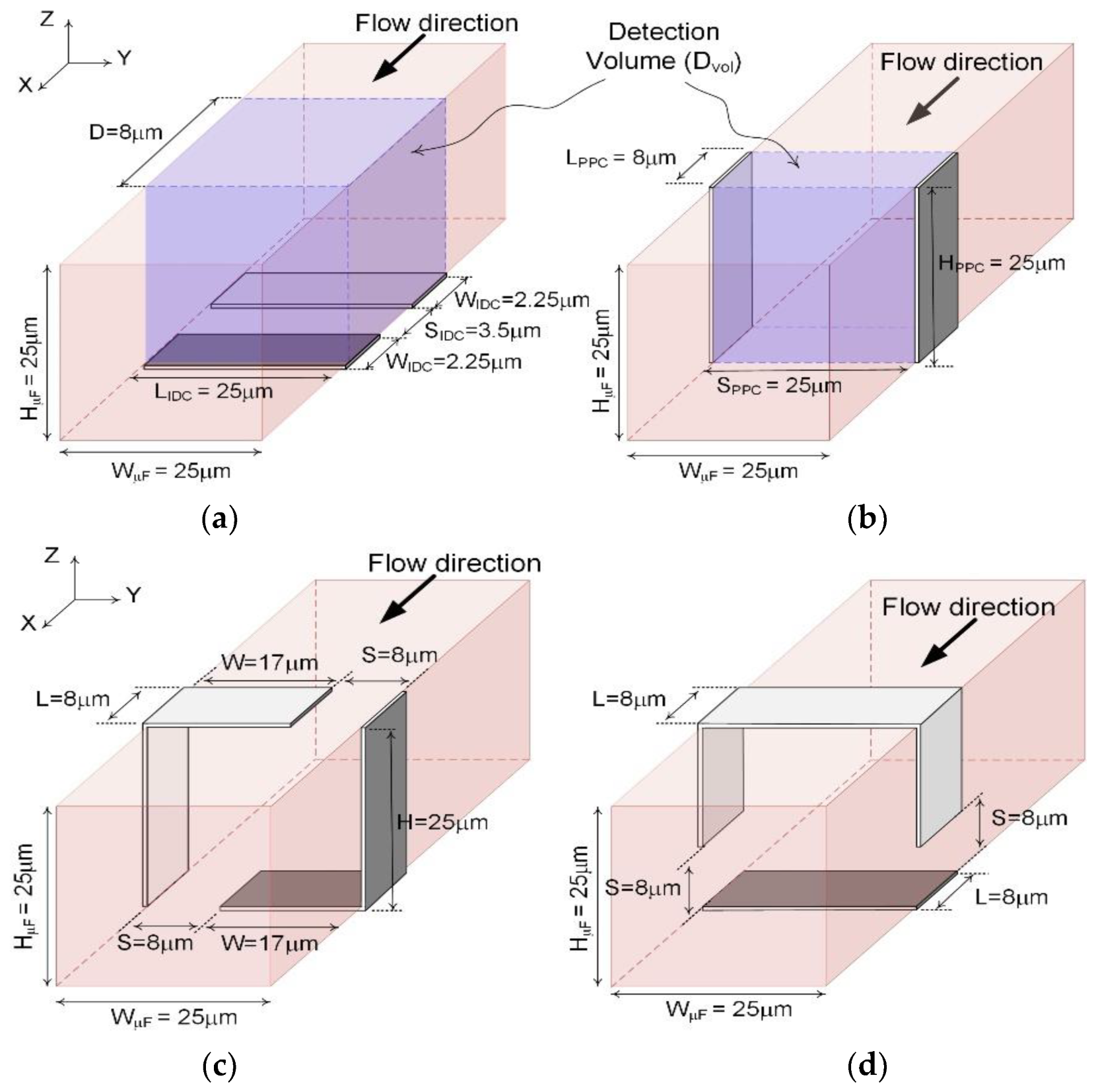
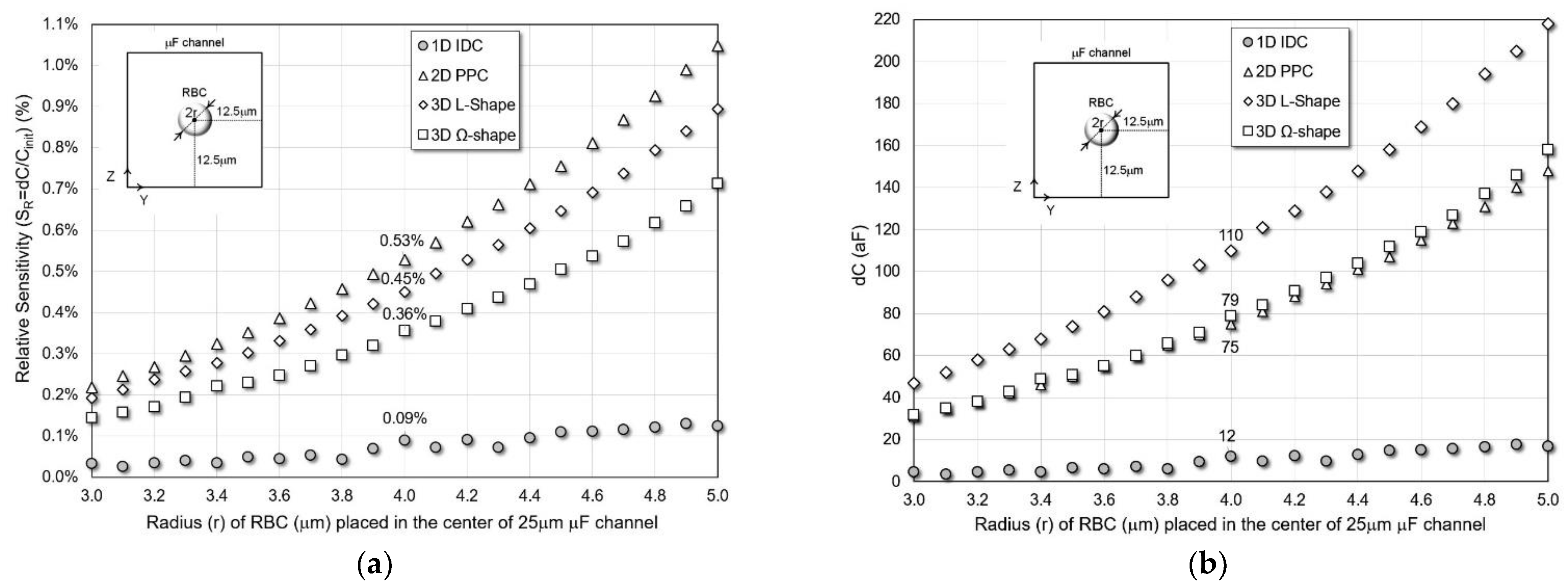
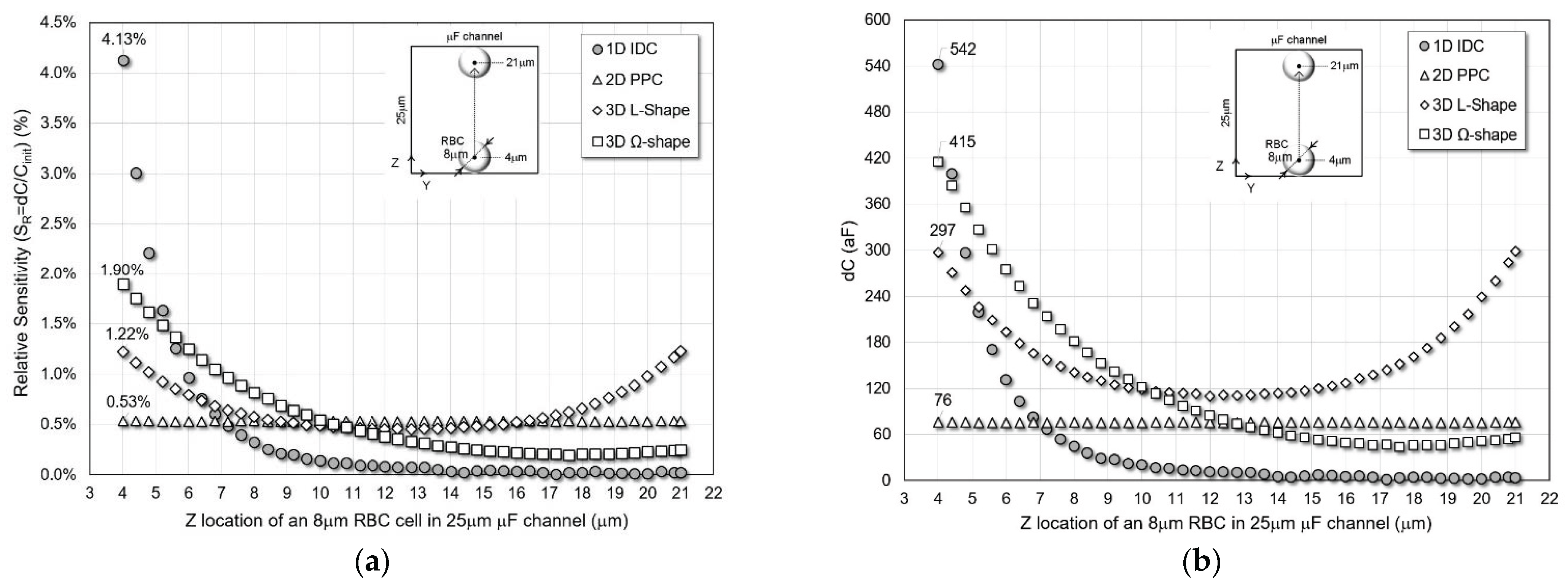

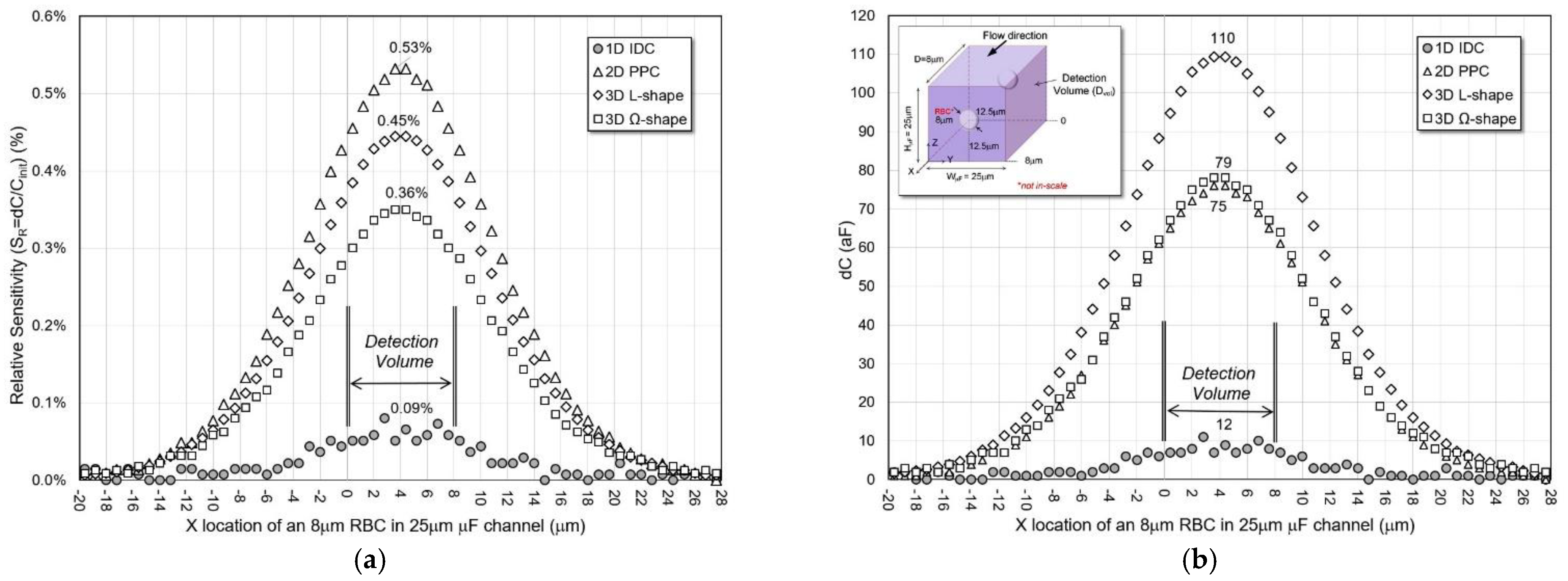
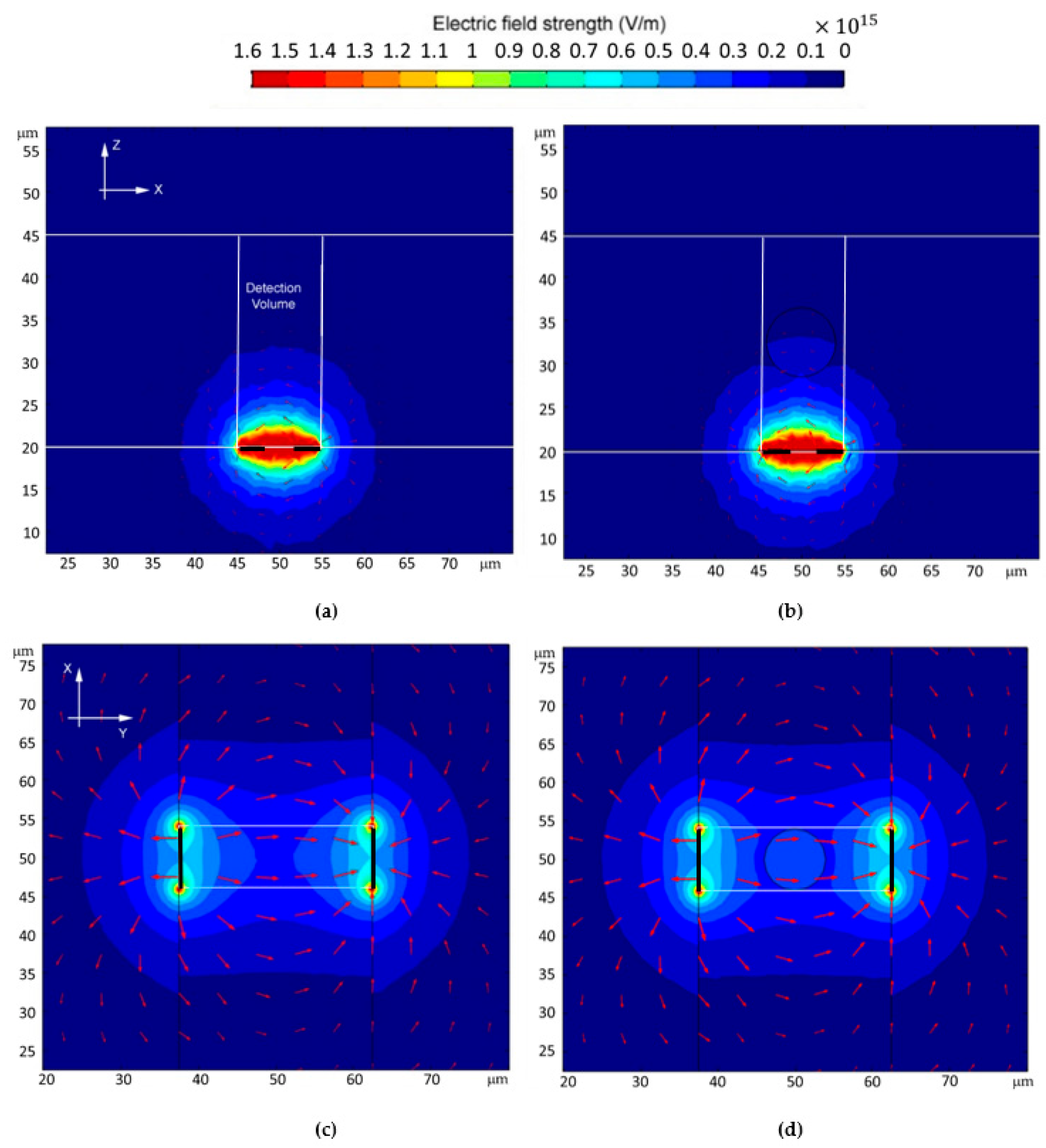

| Definition | 1D IDC | 2D PPC | 3D L-Shape | 3D Ω-Shape |
|---|---|---|---|---|
| Initial Capacitance Cinit (fF) | 13.7 | 14.3 | 24.6 | 22.3 |
| Definition | Material | Dielectric Constant | Conductivity (S/m) |
|---|---|---|---|
| Microfluidic Base | PDMS | 2.7 | insulator |
| Blood Serum | Water | 80 | 5.5 × 10−6 |
| Sensor Plates | Platinum | 1.0 | 8.9 × 10+6 |
| Detected Biomaterial | RBC | 46.98 | 0.70 |
Publisher’s Note: MDPI stays neutral with regard to jurisdictional claims in published maps and institutional affiliations. |
© 2022 by the authors. Licensee MDPI, Basel, Switzerland. This article is an open access article distributed under the terms and conditions of the Creative Commons Attribution (CC BY) license (https://creativecommons.org/licenses/by/4.0/).
Share and Cite
Hu, W.; Wu, B.; Srivastava, S.K.; Ay, S.U. Comparative Study and Simulation of Capacitive Sensors in Microfluidic Channels for Sensitive Red Blood Cell Detection. Micromachines 2022, 13, 1654. https://doi.org/10.3390/mi13101654
Hu W, Wu B, Srivastava SK, Ay SU. Comparative Study and Simulation of Capacitive Sensors in Microfluidic Channels for Sensitive Red Blood Cell Detection. Micromachines. 2022; 13(10):1654. https://doi.org/10.3390/mi13101654
Chicago/Turabian StyleHu, Wei, Bingxing Wu, Soumya K. Srivastava, and Suat Utku Ay. 2022. "Comparative Study and Simulation of Capacitive Sensors in Microfluidic Channels for Sensitive Red Blood Cell Detection" Micromachines 13, no. 10: 1654. https://doi.org/10.3390/mi13101654
APA StyleHu, W., Wu, B., Srivastava, S. K., & Ay, S. U. (2022). Comparative Study and Simulation of Capacitive Sensors in Microfluidic Channels for Sensitive Red Blood Cell Detection. Micromachines, 13(10), 1654. https://doi.org/10.3390/mi13101654








